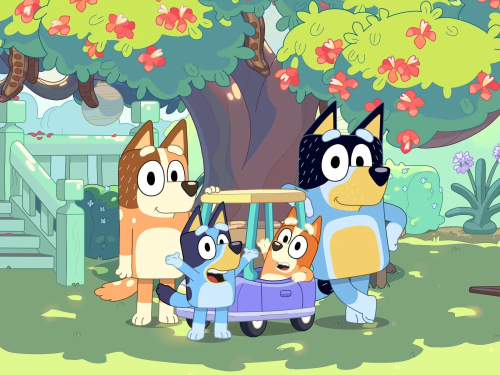
Bluey review



Bluey
When I first encountered the Australian cartoon Bluey, I approached it with casual curiosity. Yet, soon enough, it became a fixture of intrigue and delight in my household. Little did I know that this bright and seemingly simple kids' show would turn into a multi-layered experience, bringing unexpected moments of reflection and joy.
The Birth of Bluey
Bluey, the brainchild of Joe Brumm, made its debut in 2018 on the Australian Broadcasting Corporation (ABC). Conceived as an Australian response to Peppa Pig, the show offered a fresh twist on the family narrative. Unlike many previous animated dads, Bluey's Bandit redefined fatherhood in animation with humor and depth.
Brumm's background in the animation world, having worked on Charlie and Lola, equipped him with the storytelling finesse needed to craft a world that was both whimsical and sincere. He drew inspiration from his own experiences, weaving family dynamics into the well-loved episodes. The tales are universal yet particular to their sunny Brisbane setting.
Why Bluey Captivates
There's an undeniable allure to Bluey that goes beyond its vibrant palette and engaging characters. The show captures the simple joy of childhood while delving into themes that resonate with adults. Each seven-minute episode is packed with playful adventures as well as teachable moments, all without being overtly didactic.
Part of the magic lies in how the creators trust the intelligence of their audience. Children appreciate the humor and whimsy, while adults are drawn in by the thoughtful engagement with life's various complexities. It's rare in any form of media to find such a universally relatable journey, yet Bluey accomplishes just that.
Personal Impressions
Viewing Bluey for the first time, I was amazed by the depth woven into what appeared to be light entertainment. From the outset, I sensed a profound wisdom embedded in these short segments. Themes of perseverance, creativity, and familial love made each viewing session a reflective experience.
Particularly striking is the character of Bandit, Bluey's father, who shatters the archetype of the bumbling dad. Rather than existing as a figure of comic relief, Bandit engages actively and poignantly with his daughters' imaginary worlds, embodying a parenting style that is both aspirational and daunting.
The Magic of Play
Central to Bluey is the concept of play, which Brumm masterfully transforms into a narrative device. The ability to find wonder in the mundane and weave complex narratives through simple play resonates deeply. Each game turns into a voyage of self-discovery for the characters and the viewers alike.
The creative play scenes remind us of childhood's boundless realms. The show captures the idea that imagination can transform the ordinary into the extraordinary, all while teaching vital life skills. It's a reminder of the essential role play has in development, something that adults are gently prompted to remember.
Bandit: A New Breed of Animated Dad
For many parents, Bandit offers a fresh representation of fatherhood, distinguishing himself as both relatable and formidably ideal. His active participation in his daughters' escapades is depicted with such sincerity that it challenges parents to either step up their game or accept their more realistic limitations.
On screen, Bandit is humorous and wise, characteristics thoughtfully balanced with vulnerability and understanding. His portrayal has sparked conversations about modern parenting roles, switching from the hapless depiction of dad to one of rewarding engagement and partnership in parenting.
Cultural Impact and Reach
Bluey isn't just a hit in Australia. Its release on Disney+ expanded its reach, endearing itself to audiences across Europe and the US. The show’s cultural imprints are widespread, igniting debates on parenting societal roles, and showcasing Australian culture to a broader audience.
The authentic Australian accents were retained in the adaptations abroad, lending the show a unique charm and authenticity. Its universal themes and appeal bypass linguistic barriers, proving the show's ability to resonate transcends mere geographical bounds.
Musical Brilliance
A significant part of Bluey's appeal is its music. The soundtrack, cleverly riffing from classical themes to cinematic scores, enriches the viewing experience significantly. It stands as a testament to the show's consideration of every element that crafts its narrative.
Composer Joff Bush’s work effortlessly bridges playful tunes with serious tones. Each episode's music complements the unfolding drama, enhancing the emotional texture and heightening the joy and tension intrinsic to each tale.
The Thread of Storytelling
Each episode of Bluey is a finely woven tapestry of storytelling, where narrative arcs, character development, and thoughtful themes blend seamlessly. The stories are both specific to Bluey’s world and filled with universally relatable lessons.
Storylines are structured to evoke genuine emotions. They capture the essence of childhood’s joys and struggles, prompting adults to reflect on their past experiences with a sense of nostalgia and wonder.
Bluey’s Friends and Family Dynamics
Besides its main characters, Bluey introduces an array of vibrant secondary characters that enrich its universe. Each interaction within Bluey’s social circle illustrates different family dynamics and friendships, broadening the show’s exploration of relationships.
These interactions highlight diverse parenting styles and childhood experiences, subtly encouraging viewers to accept and appreciate varied approaches to life’s challenges.
Adult Viewership and Relatability
While predominantly a children’s show, Bluey has cultivated a substantial adult fanbase. Many describe the series as therapeutic, with its themes acting as catalysts for discussions about life, parenting, and personal growth.
Its ability to engage adults is not accidental. Joe Brumm deliberately crafted narratives that harmonize with both childlike wonder and mature self-discovery, offering insight into real-world challenges through a playful lens.
Building a Unique World
The setting of Bluey adds another layer of charm. Situated in suburban Brisbane, the show exhibits the everyday beauty of ordinary Australian life. The vibrant visuals and recognizable locations give a sense of place that feels real and welcoming.
The creators' precise attention to detail and the lovingly rendered environment provide a familiarity that connects with audiences worldwide, transforming cartoon landscapes into relatable worlds.
The Unspoken Pressure
As inspiring as Bluey is, it also introduces an element of parental pressure. Watching Bandit could lead many to question their own parenting performance, making them feel inadequate compared to this cartoon super-dad.
Yet, instead of fixating on shortcomings, it’s possible to view Bandit’s actions as an encouragement to engage more fully with one’s children, recognizing the realistic balance between aspiration and capability.
Bluey’s Expansive Horizons
In exploring Bluey further, it’s evident there’s more on the horizon for this beloved show. As new seasons emerge, the promise of further adventures suggests continued growth in both themes and character development.
Each new episode is eagerly anticipated, promising more laughter, introspection, and learning. It’s a testament to the timeless appeal of the cartoon, waiting to leave deeper imprints in the cultural landscape.
Conclusion: Finding Resonance with Bluey
In conclusion, Bluey is not just a children's show – it’s a narrative masterpiece that resonates with audiences of all ages. Through its focus on familial love, imagination, and life's intricacies, it offers both entertainment and enlightenment.
Whether you are captivated by Bandit’s parenting prowess, amused by Bluey’s imaginative escapades, or find solace in its quiet moments of introspection, Bluey invites us to view the world through a lens of joy and understanding, making it an essential watch for anyone seeking the delight of childhood.




















Leave a comment
Your comment is awaiting moderation. We save your draft here
0 Comments